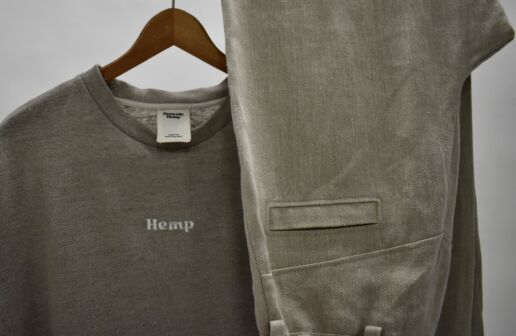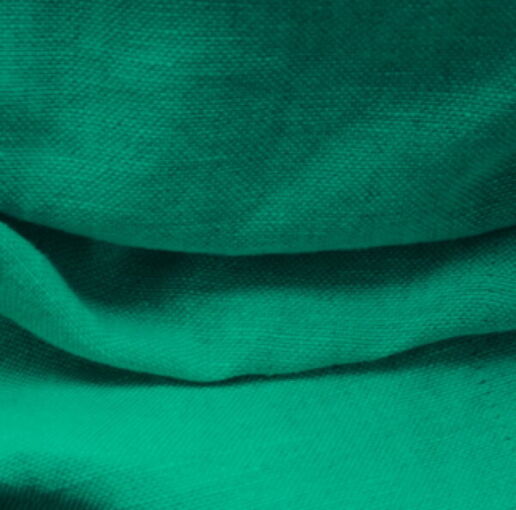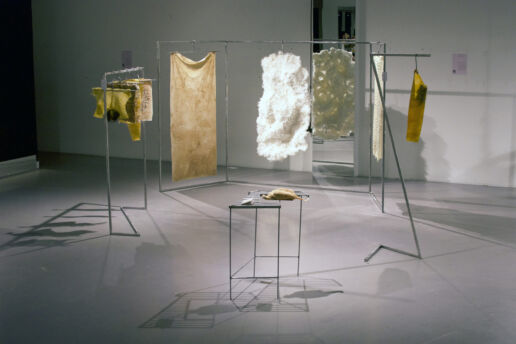Keyhouse
KEYHOUSE NEWS - Centric Software
In the atmospheric industrial charm of KEYHOUSE in Hall 7, progressive suppliers and global players from cross-industry sectors will be showcasing their latest new developments and innovations. On over 1,000 square metres, you will find trend-setting future fabrics and new process technologies – be it in terms of sustainability, circular economy, digitalisation & AI, traceability, textile dyeing or finishing. Staged as an interactive think tank, future-oriented show cases will be in the spotlight alongside sustainable innovations.
KEYHOUSE is also home to the main lecture forum of MUNICH FABRIC START with exclusive keynotes, panel discussions, trend presentations, Q&A sessions & expert talks by international industry insiders. Be inspired by the wide range of events at KEYHOUSE.
Speed product development, increase profits & boost efficiency with Centric’s PLM designed for small & mid-sized businesses
Is your emerging fashion or retail brand poised for growth and are you looking for a backbone technology solution to streamline product concept to replenishment? Have you considered implementing a modern Product Lifecycle Management (PLM) solution but think it is out of reach and only for the major industry players?
Centric Software® is thrilled to offer growing fashion brands and retailers Centric SMB. Centric SMB is our cloud-based PLM solution designed for small and mid-sized businesses and is proven to help speed product development, increase profits and boost efficiency. It gives you access to all the tools you need to gain a competitive advantage by improving your products and streamlining processes. Available on a subscription basis (SaaS), you can access the same technology and industry know-how as the large global brands.
Read on to explore the top 4 Benefits and Innovative Features of Centric SMB!
Benefit #1: Collapse Time to Market by 15% to 30%
With simplified business processes, improved supply chain collaboration and decision-making capabilities for teams, along with innovative applications like 3D proofing and review processes, brands and retailers can dramatically shorten the time frame from concept to replenishment.
Benefit #2: Increase Product Revenue by 5% to 10%
Design, product development, purchasing and buyer teams can assess key performance indicators in real time by using sales planning views, including product series portfolios, supplier performance, target sales and actual sales. This empowers them to make timely adjustments to their plans, improve the success rate of product launches and increase sales performance.
Benefit #3: Higher Profit Margins: Reduce Cost of Selling by 5% to 15%
Centric SMB can quickly and accurately calculate relationships between cost, profit and price changes according to set sales goals. Suppliers can be added to the supply chain collaboration process in advance, enabling unified global procurement. Product profitability can soar with informed, collaborative procurement plans.
Benefit #4: Increase Management and Development Efficiency by 10% to 50%
With Centric SMB, teams can reduce the number of emails, meetings and phone calls required, and dramatically reduce time wasted searching for, or updating information. PLM’s single source of real-time data powers efficiency, freeing teams to focus on value-added business critical functions.
“We needed a solution that was accessible from anywhere, available to us at all times and adaptable enough to grow as we did. Centric SMB was affordable, had everything we needed out of the box and the suite of additional modules made sure it would be scalable as our needs evolved.” – tentree



Innovative Feature #1: Mobile Apps
In today’s rapidly moving global apparel industry being able to conduct business from anywhere at any time if crucial for success. Centric SMB’s wide range of 15 mobile apps give users the power to capture data outside of the scope of traditional methods and let teams work with ease, on the move. Centric SMB apps include Capture It (to collect image inspiration), Product Notes, Sample Review, 3D Sample Review, Collection Book Fit Review, Retail Review and more!
Innovative Feature #2: Adobe® Connect
This powerful app enables designers to use Adobe® Illustrator within Centric SMB. This easy to use, class-leading link between PLM and designers’ tool of choice allows users to work 100% within the PLM environment. Empower designers to sketch and create colors and other product information, start building Bills of Material and seamlessly access textiles, fabrics and colors from within Centric SMB.
Innovative Feature #3: 3D Connect
Centric developed a 3D agnostic strategy so that information flows seamlessly between multiple 3D applications. With 3D Connect designers work in their native 3D environment while connected directly to PLM to harness the power of 3D at every stage of the product lifecycle. 3D Connect integrates with leading 3D apparel design and development CAD solutions including Browzwear, SOLIDWORKS, Optitex and CLO 3D.
Innovative Feature #4: AI Image Search
Creative teams in fashion and retail collect enormous amounts of digital and physical samples of materials, trims, colors and styles that serve both as inspiration for the future and as a record of the past. The challenge is finding what they need can be like searching for a needle in a haystack and hundreds of hours can be wasted. With Centric AI Image Search, designers can take a picture of a new fabric or trim inspiration and instantly search PLM image archives to find the closest match and if a similar item has been approved or used before, a designer can find out immediately. AI Image search can also connect designers to suppliers with a close match, saving teams massive amounts of time and improving design and development decisions.
“Having Centric in place saves everyone about 10-15 percent of their time on a day to day basis, mainly because people don’t have to spend time searching for the right answers, asking questions and re-confirming whether information is up to date.” – Marine Layer
Conclusion
Emerging fashion brands and retailers are operating in a wildly competitive marketplace and need every tool and advantage to survive and thrive. Centric SMB delivers speed, functionality and simplicity to drastically improve products and streamline processes.
With zero down-time, automatic upgrades and scalability, Centric SMB is the PLM solution that grows with you!
Isn’t it time to discover why more than 815+ companies representing 17,500+ brands, including Hugo Boss, Lacoste, Triumph, s. Oliver, Tom Tailor, Ortovox, Deuter, ON Running, Armed Angels, Blutsgeschwister trust their business to Centric Software?
Visit the KEYHOUSE AT HALL 7 to find the latest innovations in textiles, production and technology.

THIS MIGHT BE ALSO INTERESTING FOR YOU
KEYHOUSE NEWS – PaperTale
15. January 2025
Whether you’re exploring product traceability, seeking to streamline compliance, or driving sustainability, PaperTale provides the tools to stay ahead in a rapidly evolving industry.
Additionals Trends Spring.Summer 26 – Part 6
15. January 2025
From timeless luxury to durable workwear solutions, each collection reflects their commitment to responsible sourcing and innovative design.
SPRING.SUMMER 26 FABRIC HIGHLIGHTS & MATERIAL NOVELTIES – PART IV
14. January 2025
The colour palette of the 2026 summer collection invites you to dream.
Additionals Trends Spring.Summer 26 – Part 5
14. January 2025
Denim is more than just fabric—it is a cultural phenomenon. It represents resilience, creativity, and individuality.
Additionals Trends Spring.Summer 26 – Part 4
13. January 2025
The Hackenberg Textile Group has been your partner for tapes, waistbands, textiles and labels since 1873 and offers textile solutions for all industries.
COLORWAYXPRESS & ECOLORWAY
13. January 2025
ColorwayXpress and eColorway are two powerful software solutions tailored to meet these needs by enhancing efficiency in creating colorways and accelerating creative processes.
BLUEZONE NEWS FOR JANUARY 2025 – PART V
12. January 2025
By combining the softness and flexibility of knit fabrics with the durability of woven denim, Comfort2 introduces a weave, with stretch in the warp and in the weft, that moves effortlessly with the body.
The AFTERLIFE Project by Oscar Wentz
12. January 2025
In an industry swamped by fast fashion and ever-changing trends, Oscar Wentz’s AFTERLIFE project has hit the reset button.
BLUEZONE NEWS FOR JANUARY 2025 – PART IV
11. January 2025
Designed with an eye for elegance and originality, this exclusive collection invites designers and brands to explore fabrics that tell stories through texture, technique, and artistry.
Additionals Trends Spring.Summer 26 – Part 3
11. January 2025
Nostalgia also plays a central role in fashion, often reinterpreting historical styles to create a bridge between tradition and innovation. Fashion pieces are intended to embody elegance and a personal touch.
KEYHOUSE NEWS - T-Rex
In the atmospheric industrial charm of KEYHOUSE, Hall 7, progressive suppliers and global players from cross-industry sectors will be showcasing their latest new developments and innovations. On over 1,000 square metres, you will find trend-setting future fabrics and new process technologies – be it in terms of sustainability, circular economy, digitalisation & AI, traceability, textile dyeing or finishing. Staged as an interactive think tank, future-oriented show cases will be in the spotlight alongside sustainable innovations.
KEYHOUSE is also home to the main lecture forum of MUNICH FABRIC START with exclusive keynotes, panel discussions, trend presentations, Q&A sessions & expert talks by international industry insiders. Be inspired by the wide range of events at KEYHOUSE.
Working towards a scalable solution for textile-to textile recycling: Introducing the T-REX Project
Today, only 2% of post-consumer textiles in the EU are diverted to fibre-to-fibre recycling. The T-REX (Textile Recycling Excellence) Project brings together 13 major players from the textile industry along with research institutions to create a harmonised EU blueprint for closed loop sorting, and recycling of household textile waste.



Drishti Masand, Senior Manager, Sustainability Direction – adidas
Across a three-year period, the EU-funded T-REX Project l is working to collect and sort household textile waste and demonstrate the full recycling process of polyester, polyamide 6, and cellulosic materials from textile waste into new garments.
“Circularity is a team sport, and we need to play together to win – this is the ethos of the circularity work at adidas. By bringing together major players across the whole value chain, the T-REX Project aims to demonstrate a new ecosystem approach, with harmonised methods and quality criteria.” – Drishti Masand
The project ultimately aims to develop systemic solutions to the problem of textile waste by identifying the infrastructure, technology, and policy needed to encourage the growth of circular value chains in the textile industry. At the same time, the consortium will also work on assessing how citizens can be empowered to actively contribute to the transition towards a circular textiles system.
“Currently, innovative materials like textile-to-textile recycled fibres constitute less than 1% of the fibre mix. A combination of brand commitment, legislation, and regulation can accelerate the adoption of next-gen materials.” – Jyotsna Gopinath

Jyotsna Gopinath, Innovation Analyst – Fashion for Good
Drishti Masand, Senior Manager, Sustainability Direction at adidas, and Jyotsna Gopinath, Innovation Analyst at Fashion for Good, will delve into the insights and learnings garnered from the project so far in an upcoming talk and panel discussion within the KEYHOUSE area programme, moderated by Muchaneta ten Napel.
Join the “IN CONVERSATION WITH Drishti Masand” session on Tuesday, 3rd September at 11am
&
Don’t miss to be part of the Panel Discussion on “Closing the Loop: Breaking Down Barriers in Fiber Recycling for Fashion” on Wednesday, 4th September at 3pm
TREND LECTURES | KEYHOUSE – Hall 7

Muchaneta ten Napel, Founder & CEO – Shape Innovate
THIS MIGHT BE ALSO INTERESTING FOR YOU
KEYHOUSE NEWS – PaperTale
15. January 2025
Whether you’re exploring product traceability, seeking to streamline compliance, or driving sustainability, PaperTale provides the tools to stay ahead in a rapidly evolving industry.
Additionals Trends Spring.Summer 26 – Part 6
15. January 2025
From timeless luxury to durable workwear solutions, each collection reflects their commitment to responsible sourcing and innovative design.
SPRING.SUMMER 26 FABRIC HIGHLIGHTS & MATERIAL NOVELTIES – PART IV
14. January 2025
The colour palette of the 2026 summer collection invites you to dream.
Additionals Trends Spring.Summer 26 – Part 5
14. January 2025
Denim is more than just fabric—it is a cultural phenomenon. It represents resilience, creativity, and individuality.
Additionals Trends Spring.Summer 26 – Part 4
13. January 2025
The Hackenberg Textile Group has been your partner for tapes, waistbands, textiles and labels since 1873 and offers textile solutions for all industries.
COLORWAYXPRESS & ECOLORWAY
13. January 2025
ColorwayXpress and eColorway are two powerful software solutions tailored to meet these needs by enhancing efficiency in creating colorways and accelerating creative processes.
BLUEZONE NEWS FOR JANUARY 2025 – PART V
12. January 2025
By combining the softness and flexibility of knit fabrics with the durability of woven denim, Comfort2 introduces a weave, with stretch in the warp and in the weft, that moves effortlessly with the body.
The AFTERLIFE Project by Oscar Wentz
12. January 2025
In an industry swamped by fast fashion and ever-changing trends, Oscar Wentz’s AFTERLIFE project has hit the reset button.
BLUEZONE NEWS FOR JANUARY 2025 – PART IV
11. January 2025
Designed with an eye for elegance and originality, this exclusive collection invites designers and brands to explore fabrics that tell stories through texture, technique, and artistry.
Additionals Trends Spring.Summer 26 – Part 3
11. January 2025
Nostalgia also plays a central role in fashion, often reinterpreting historical styles to create a bridge between tradition and innovation. Fashion pieces are intended to embody elegance and a personal touch.
KEYHOUSE NEWS - Archroma
In the atmospheric industrial charm of KEYHOUSE, Hall 7, progressive suppliers and global players from cross-industry sectors will be showcasing their latest new developments and innovations. On over 1,000 square metres, you will find trend-setting future fabrics and new process technologies – be it in terms of sustainability, circular economy, digitalisation & AI, traceability, textile dyeing or finishing. Staged as an interactive think tank, future-oriented show cases will be in the spotlight alongside sustainable innovations.
KEYHOUSE is also home to the main lecture forum of MUNICH FABRIC START with exclusive keynotes, panel discussions, trend presentations, Q&A sessions & expert talks by international industry insiders. Be inspired by the wide range of events at KEYHOUSE.

JOIN ARCHROMA AT THE KEYHOUSE:
Game-changing approach delivers planet conscious, trendy denim
In the fast-paced world of denim fashion, Archroma stands as a pioneering force, collaborating with global denim brands and mills to drive the industry towards a greater focus on sustainability, and cater to evolving consumer preferences.
Their latest innovation, DENIM HALO, represents a fresh approach to denim production, blending lower environmental impact with simplicity. This concept introduces an exclusive chemical technology alongside efficient pretreatment and dyeing processes. By superficially dyeing the yarn, DENIM HALO achieves the desired aesthetic while drastically reducing the environmental footprint of denim finishing. This approach eliminates the need for harmful processes such as manual scraping or potassium permanganate spraying. The end result? One of the industry’s most sustainable laser friendly and easy to wash denim, marking a significant stride towards denim that is more planet conscious.
For the classic blue jeans, Archroma’s aniline-free* (Typically more than 95% lower than current industry standard limits. For further information please refer to The Safe Edge portal.) DENISOL® PURE INDIGO 30 dyes, boasting up to 40% water savings compared to conventional dyeing and laundry finishing methods. Meanwhile, the DIRESUL® SMARTDENIM BLUE pre-reduced sulfur dye delivers savings of up to 70%, ensuring a distinctive blue denim look. For black denim enthusiasts, DIRESUL® EVOLUTION BLACK reduces water usage by up to 56% during dyeing and finishing processes, creating unique wash-down effects with a remarkable 57% reduction in overall environmental impact compared to standard sulfur black in synthesis (Life Cycle Analysis by Ecoterrae).



To validate the eco-credentials of their laser-friendly denim fabrics, Archroma collaborates closely with Jeanologia, a global leader in laser technology. The assessments highlight DENIM HALO’s exceptional performance in ‘Light Sensitive Fabric’ and ‘Environmental Impact Measurement’ tests, where in both tests, the DENIM HALO application far exceeds the current ring dyeing market standard.
In essence, Archroma’s commitment to innovation and sustainability not only transforms denim manufacturing but also aligns with conscientious consumer demands for more planet conscious fashion choices. Through DENIM HALO and its array of solutions, Archroma continues to shape the future of denim, one garment at a time.
*Below limits of detection according to industry standard test methods
**Life Cycle Analysis by Ecoterrae
Switzerland – H7 KH | K12

Figure 1: Light Sensitive Fabric

Figure 2: Environmental Impact Measurement
THIS MIGHT BE ALSO INTERESTING FOR YOU
KEYHOUSE NEWS – PaperTale
15. January 2025
Whether you’re exploring product traceability, seeking to streamline compliance, or driving sustainability, PaperTale provides the tools to stay ahead in a rapidly evolving industry.
Additionals Trends Spring.Summer 26 – Part 6
15. January 2025
From timeless luxury to durable workwear solutions, each collection reflects their commitment to responsible sourcing and innovative design.
SPRING.SUMMER 26 FABRIC HIGHLIGHTS & MATERIAL NOVELTIES – PART IV
14. January 2025
The colour palette of the 2026 summer collection invites you to dream.
Additionals Trends Spring.Summer 26 – Part 5
14. January 2025
Denim is more than just fabric—it is a cultural phenomenon. It represents resilience, creativity, and individuality.
Additionals Trends Spring.Summer 26 – Part 4
13. January 2025
The Hackenberg Textile Group has been your partner for tapes, waistbands, textiles and labels since 1873 and offers textile solutions for all industries.
COLORWAYXPRESS & ECOLORWAY
13. January 2025
ColorwayXpress and eColorway are two powerful software solutions tailored to meet these needs by enhancing efficiency in creating colorways and accelerating creative processes.
BLUEZONE NEWS FOR JANUARY 2025 – PART V
12. January 2025
By combining the softness and flexibility of knit fabrics with the durability of woven denim, Comfort2 introduces a weave, with stretch in the warp and in the weft, that moves effortlessly with the body.
The AFTERLIFE Project by Oscar Wentz
12. January 2025
In an industry swamped by fast fashion and ever-changing trends, Oscar Wentz’s AFTERLIFE project has hit the reset button.
BLUEZONE NEWS FOR JANUARY 2025 – PART IV
11. January 2025
Designed with an eye for elegance and originality, this exclusive collection invites designers and brands to explore fabrics that tell stories through texture, technique, and artistry.
Additionals Trends Spring.Summer 26 – Part 3
11. January 2025
Nostalgia also plays a central role in fashion, often reinterpreting historical styles to create a bridge between tradition and innovation. Fashion pieces are intended to embody elegance and a personal touch.
The Warp Of Symbiogenesis - Sustainable Innovations
In the universe of “The Warp of Symbiogenesis,” a collection of woven fabrics unfolds, aiming to foster appreciation for the intricate interconnections among Earth’s organisms. These fabrics carry five stories of invisible connections, narrating tales of cooperation, exploitation, and competition among fungi, lichens, corals, and plants. Each symbiotic relationship inspires a distinct weaving pattern, symbolizing the unique interactions between two species. Crafted from natural fibers sourced in Europe, the textile collection invites a reconsideration of the impact and interdependence shared by all organic life forms.
How do we begin to listen to the stories of the planet? By being present in the interweaving of life, of which we are a part and always have been. As a queer speculator, designer, and researcher, Paul Schaffer is fascinated by the systems influencing our social behavior and relationship with nature. Concentrating on visual media and textiles, his work seeks to deconstruct and visually articulate the heteronormative nature of these systems. Motivated by profound curiosity and a love for research, Schaffer continually strives to comprehend systems in novel ways, addressing sensitive topics with utmost care.



———————————————————————–
DIES KÖNNTE SIE AUCH INTERESSIEREN
SPRING.SUMMER 26 FABRIC HIGHLIGHTS & MATERIAL NOVELTIES – PART V
19. January 2025
Their philosophy,“Drawing art with threads, conveying emotions through embroidery,” ensures every product is not just visually stunning but also deeply meaningful.
The Source Collection’s News at MUNICH FABRIC START
19. January 2025
Neutral sand mélange and off-white jacquards set a sophisticated tone, while soft yarn jersey pieces bring effortless comfort.
Additionals Trends Spring.Summer 26 – Part 7
18. January 2025
Whether haptic or visual - it's all about contrasts, which in combination provide impulses and demand new ways of thinking. Perfect for brands that want to make bold statements!
Honestly Hemp - Sustainable Innovations
Hemp: a truly versatile plant, once one of the main sources of man-made textiles. Today, most of us know it under the names “cannabis” or “marijuana”, which tend to evoke predominantly negative connotations. Design Academy Eindhoven alumna Natasha Amisha sought to investigate the source of this disconnect with her graduate project “Honestly Hemp”. Her vision: to create an entire outfit made wholly from hemp fibre and end the stigma surrounding the plant.
Natasha soon discovered that our tainted view of the hemp plant is mainly based on misconceptions, and that it could be a key ingredient in helping the textile industry become more sustainable. Not only is hemp a robust plant that thrives in diverse conditions, it also requires minimal water, is among nature’s strongest fibers, thus ensuring long-lasting life cycles, boosts sustainable agriculture as it enhances soil quality and is antibacterial, UV resistant and hypoallergenic. With “Honestly Hemp”, she has set out to place this fascinating natural material at the forefront of sustainable solutions for the future of the textile industry.
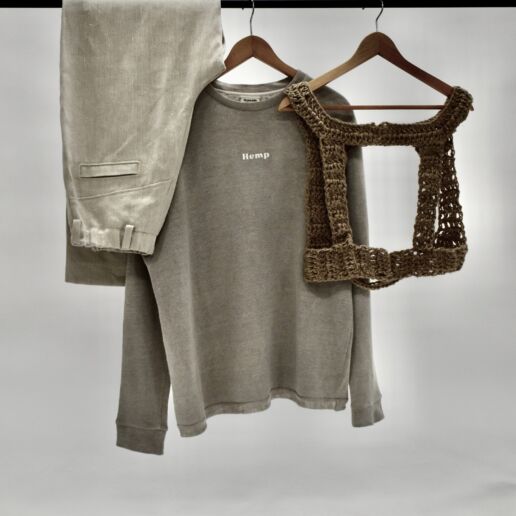
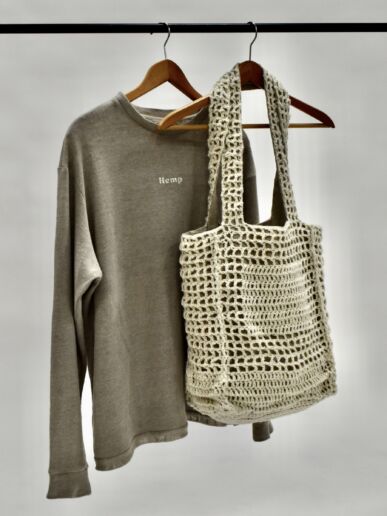
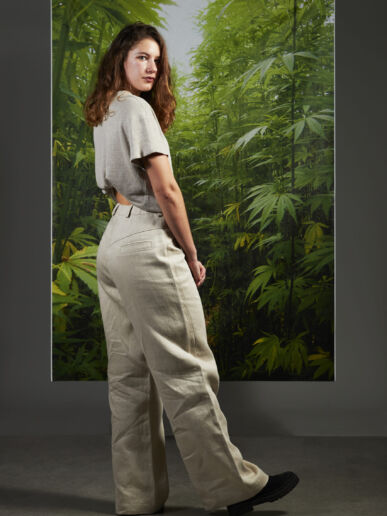
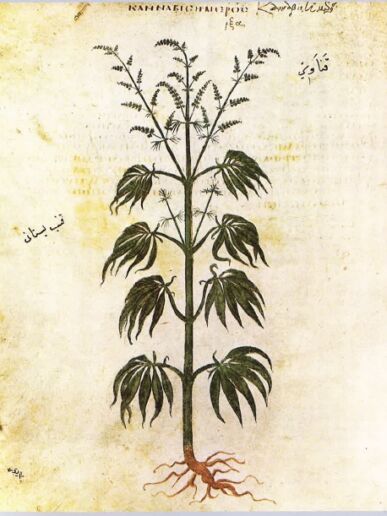
———————————————————————–
THIS MIGHT BE ALSO INTERESTING FOR YOU
SPRING.SUMMER 26 FABRIC HIGHLIGHTS & MATERIAL NOVELTIES – PART V
19. January 2025
Their philosophy,“Drawing art with threads, conveying emotions through embroidery,” ensures every product is not just visually stunning but also deeply meaningful.
The Source Collection’s News at MUNICH FABRIC START
19. January 2025
Neutral sand mélange and off-white jacquards set a sophisticated tone, while soft yarn jersey pieces bring effortless comfort.
Additionals Trends Spring.Summer 26 – Part 7
18. January 2025
Whether haptic or visual - it's all about contrasts, which in combination provide impulses and demand new ways of thinking. Perfect for brands that want to make bold statements!
BioBase - Sustainable innovations
BIOBASE, a central project within the BIOTEXFUTURE cluster, introduces sustainable alternatives from available resources for textile applications with competitive costs and properties. The overarching BIOTEXFUTURE project, led by the Institute for Textile Technology at RWTH Aachen (ITA), the Chair for Technology and Organizational Sociology (STO) at RWTH Aachen, and sportswear manufacturer adidas, aims for the transition of the entire textile value
chain to biobased materials.
BIOBASE is motivated by the challenge of dependence on fossil raw materials in the production of synthetic polymers, which poses ecological, economic, and political risks. The project targets the establishment of biobased polymers in the textile industry, demonstrating their full potential. Key sectors of the German textile industry, including automotive, sportswear, interiors, and technical textiles, are the focal points.
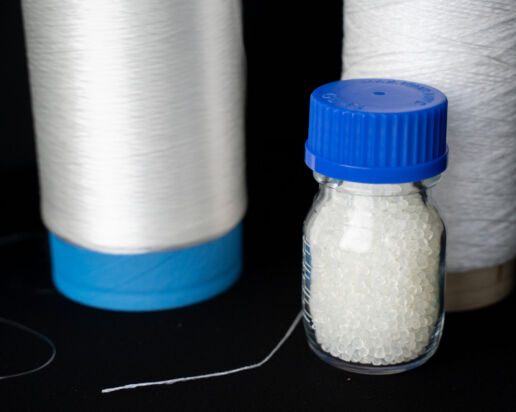
Within the BIOBASE project, the entire textile value chain of selected products is traversed. By gradually increasing the technological maturity level from Technology Readiness Level (TRL) 4 to TRL 6–7, the industrial production of biobased and sustainable man-made fibers is advanced. Polymers, yarns, and textile surfaces are developed based on applications, considering technical requirements of the industries.
The collaboration between research institutions and industrial partners allows the creation of industrially produced demonstrators, unfolding a beacon effect for the German bioeconomy and showcasing the potential of biobased polymers available in the market. The project also identifies further research and development potential for the BIOTEXFUTURE innovation area, which can be implemented in subsequent sub-projects.
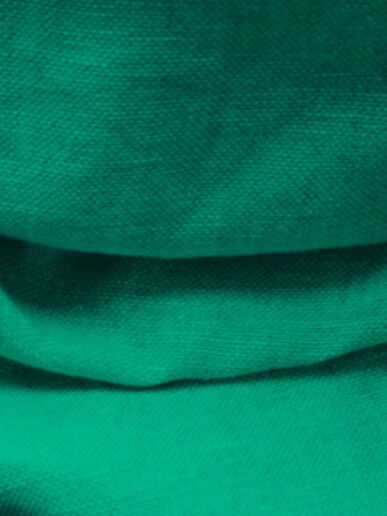
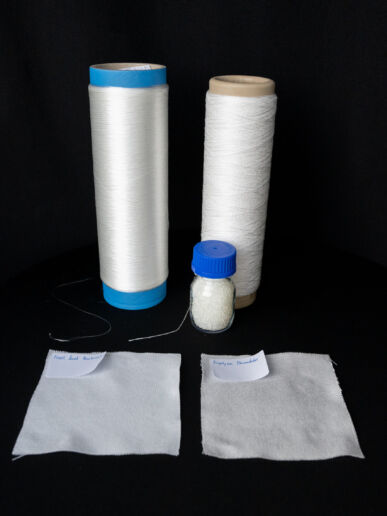
———————————————————————–
THIS MIGHT BE ALSO INTERESTING FOR YOU
SPRING.SUMMER 26 FABRIC HIGHLIGHTS & MATERIAL NOVELTIES – PART V
19. January 2025
Their philosophy,“Drawing art with threads, conveying emotions through embroidery,” ensures every product is not just visually stunning but also deeply meaningful.
The Source Collection’s News at MUNICH FABRIC START
19. January 2025
Neutral sand mélange and off-white jacquards set a sophisticated tone, while soft yarn jersey pieces bring effortless comfort.
Additionals Trends Spring.Summer 26 – Part 7
18. January 2025
Whether haptic or visual - it's all about contrasts, which in combination provide impulses and demand new ways of thinking. Perfect for brands that want to make bold statements!
Blooming Minds - Sustainable Innovations
Elizabeth Balado is an artist, designer, and researcher from London, presenting a unique, experientially-driven workshop with her project “Blooming Minds: Social Printing”. Developed over the past year, the workshop combines the psychological and physical benefits of nature with community-based creation, by guiding participants to create their own prints. The workshop encourages participants to follow their own intuition to select and forage flowers and plants and then arrange a composition, before using a technique to transfer the natural dye onto cotton using a mallet.
She will be presenting a variation of the workshop at the KEYHOUSE during Munich Fabric Start, which will consist of participants applying the print technique onto tote bags, allowing them to create and keep their own work. Elizabeth’s research focuses on combining nature – especially the use of natural and recycled materials – and community, a social practice which weaves themes such as mental health while encouraging accessible creativity. Her current work can be found on her Instagram and website. Elizabeth is open to collaboration with foragers, biologists, mental health services and others interested about participating in further printing workshops.
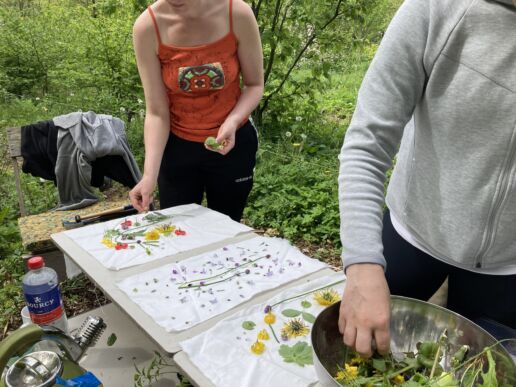
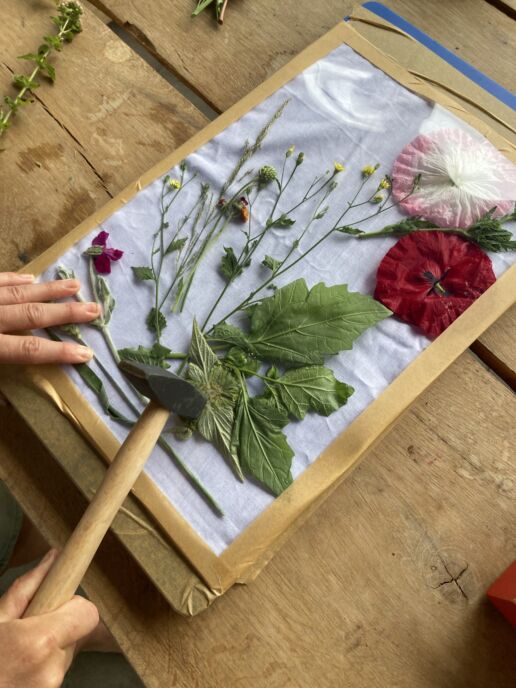
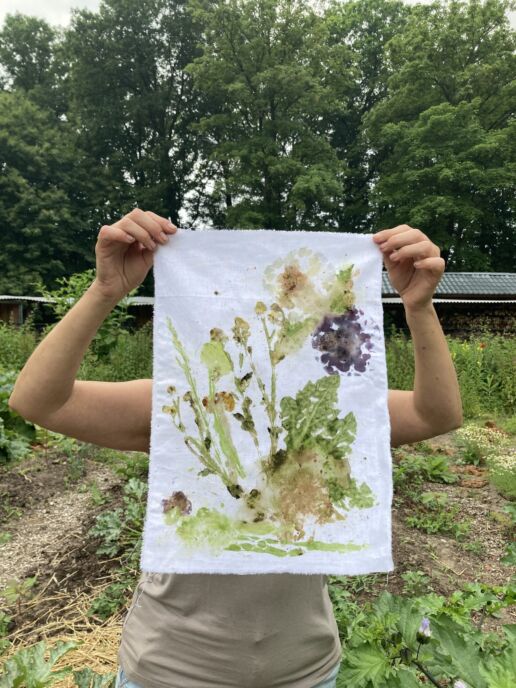

———————————————————————–
THIS MIGHT BE ALSO INTERESTING FOR YOU
SPRING.SUMMER 26 FABRIC HIGHLIGHTS & MATERIAL NOVELTIES – PART V
19. January 2025
Their philosophy,“Drawing art with threads, conveying emotions through embroidery,” ensures every product is not just visually stunning but also deeply meaningful.
The Source Collection’s News at MUNICH FABRIC START
19. January 2025
Neutral sand mélange and off-white jacquards set a sophisticated tone, while soft yarn jersey pieces bring effortless comfort.
Additionals Trends Spring.Summer 26 – Part 7
18. January 2025
Whether haptic or visual - it's all about contrasts, which in combination provide impulses and demand new ways of thinking. Perfect for brands that want to make bold statements!
Being Plucked - Sustainable Innovations
Suzanne Corcessin’s “Being Plucked” (“Être à Fleur de Peau”) utilizes unconventional textiles to argue against the notion that bird plucking and hair removal are neutral actions. Suzanne Corcessin views these acts as political, maintaining colonial and gendered hierarchies. Through bird plucking and the aesthetics of hair removal, bodies historically have been controlled and objectified.
The installation employs latex, textiles, silicone, and feathers to create textures that confront viewers with conflicting emotions, provoking new perspectives on the debate over hair removal. In this everyday decision and product debate, the question arises: Who decides what is right or wrong, beautiful or unattractive?
“Being Plucked” questions underlying assumptions and illuminates the political dimensions of decisions about one’s body. By creating textiles that evoke discomfort, Suzanne Corcessin urges a shift in the perception of the act of hair removal, breaking through the colonial and gendered structures often associated with this topic.
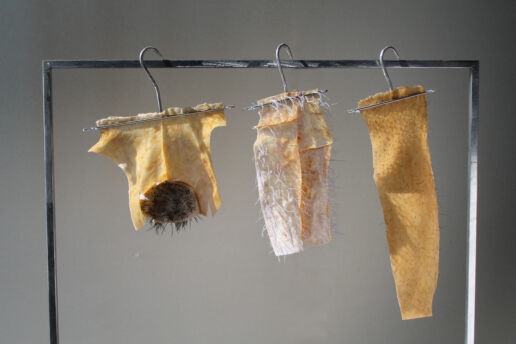
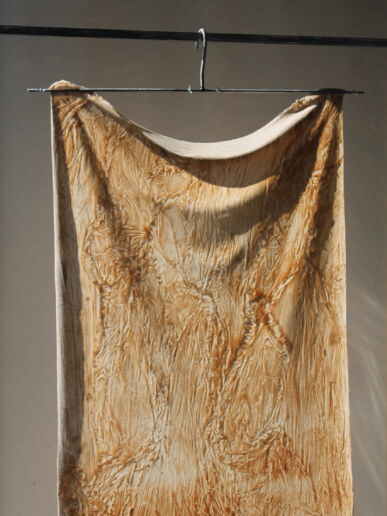
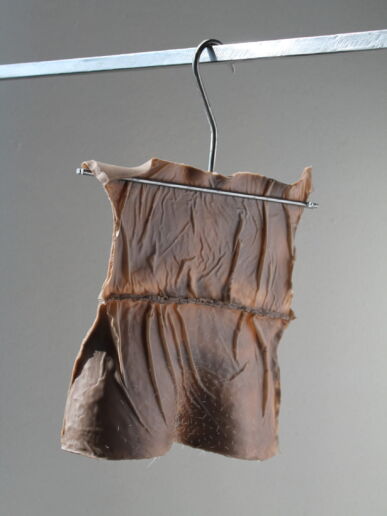
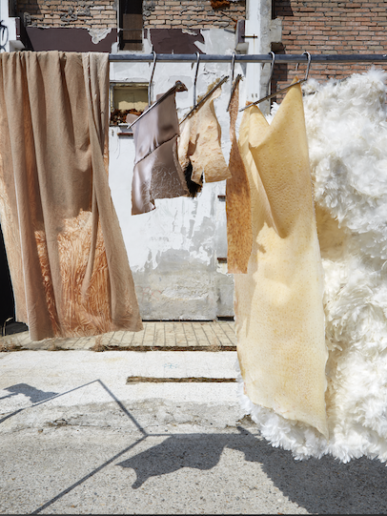
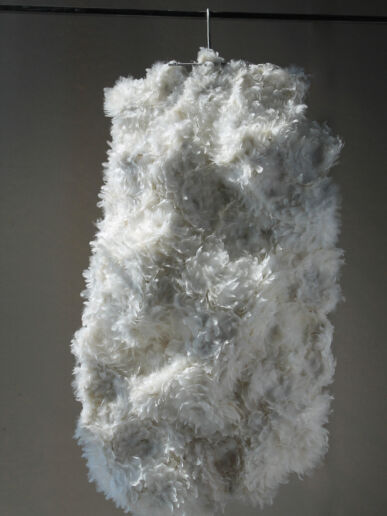
———————————————————————–
THIS MIGHT BE ALSO INTERESTING FOR YOU
SPRING.SUMMER 26 FABRIC HIGHLIGHTS & MATERIAL NOVELTIES – PART V
19. January 2025
Their philosophy,“Drawing art with threads, conveying emotions through embroidery,” ensures every product is not just visually stunning but also deeply meaningful.
The Source Collection’s News at MUNICH FABRIC START
19. January 2025
Neutral sand mélange and off-white jacquards set a sophisticated tone, while soft yarn jersey pieces bring effortless comfort.
Additionals Trends Spring.Summer 26 – Part 7
18. January 2025
Whether haptic or visual - it's all about contrasts, which in combination provide impulses and demand new ways of thinking. Perfect for brands that want to make bold statements!
Revoltech - Sustainable Innovations
Lucas Fuhrmann, the visionary behind Revoltech, inaugurates a transformative era of presentation technology that amalgamates nature, technology, and sustainability. Through innovative light columns, he creates unique experiences that not only impress aesthetically but also underscore Revoltech’s
commitment to transparency and eco-friendliness.
The revolution of Revoltech lies in the use of Hemp-Leder, an advanced fusion of hemp fibers and traditional leather. This sustainable material choice reflects Revoltech’s endeavor to promote environmentally friendly and ethical practices. The physical location of Revoltech at Darmstadt, is not just a hub of progress but also a symbol of innovation and design.
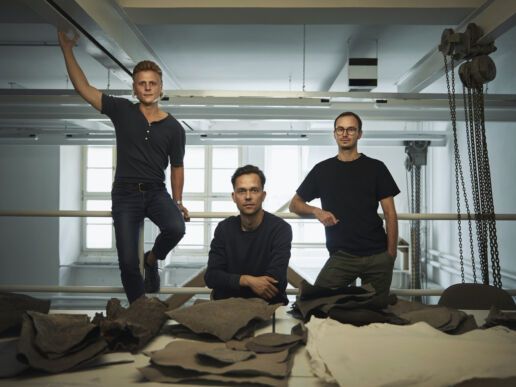
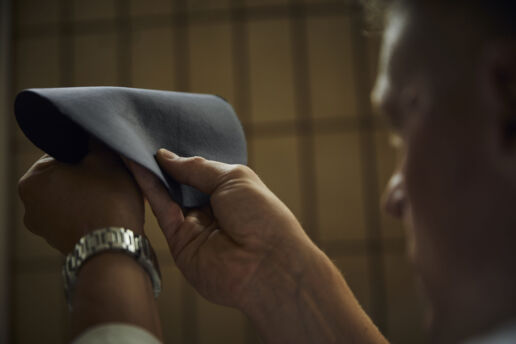
Revoltech is changing the rules of the textile industry with LOVR, a revolutionary material marking the beginning of a sustainable textile revolution. LOVR, based on hemp remnants, is entirely recyclable and biodegradable, with no plastic components. With a minimal ecological footprint, LOVR can be produced carbon-neutral, finding versatile applications in furniture, fashion, and the automotive industry.
Revolutionizing the way materials are made is Revoltech’s mission. Their story began in 2021 as a spin-off from TU Darmstadt, driven by the belief that the textile industry needs a transformation. With LOVR, they make a clear statement for sustainable innovation and a future without compromises.
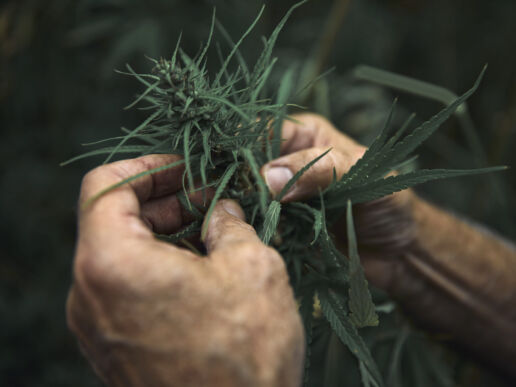

———————————————————————–
THIS MIGHT BE ALSO INTERESTING FOR YOU
SPRING.SUMMER 26 FABRIC HIGHLIGHTS & MATERIAL NOVELTIES – PART V
19. January 2025
Their philosophy,“Drawing art with threads, conveying emotions through embroidery,” ensures every product is not just visually stunning but also deeply meaningful.
The Source Collection’s News at MUNICH FABRIC START
19. January 2025
Neutral sand mélange and off-white jacquards set a sophisticated tone, while soft yarn jersey pieces bring effortless comfort.
Additionals Trends Spring.Summer 26 – Part 7
18. January 2025
Whether haptic or visual - it's all about contrasts, which in combination provide impulses and demand new ways of thinking. Perfect for brands that want to make bold statements!
A Life As An Art Project - Sustainable Innovations
To artist Sophie Conroy, her life is an experiment. In her latest work, she chose to live without her own house for 6 months in Eindhoven, on a quest to find more connected ways of living. During this time, she experienced living amidst chaos and connection. She found various forms of shelter and witnessed the beauty of her community. Through observing her fundamental human needs, she aims to grasp their authentic essence. Embracing the discomfort of houselessness allowed her to uncover valuable insights, challenging traditional notions of art, ownership, and community.
Textiles, for Sophie, become a medium that provides protection while revealing the vulnerability of the self. Confronting existential challenges during her houselessness, textiles transform into symbols of resilience and self-discovery.
Sophie crafts her textiles using primarily found materials, notably her own clothing. She believes in the power of textiles as a communication tool, using them to capture the essence of community and home. She peels away the capitalist consumer dimension of fabric, recognising it as a fundamental connection between body and environment.
Sophie Conroy doesn’t just create artworks; she constructs spaces for dialogue and interaction. Her installations incorporate videos, tapestries, drawings, writing and projections, creating a captivating fusion of textiles and visual art. The space and Sophie herself become part of the art, inviting observers to immerse themselves in this interactive environment.
Sophie emphasises that our focus should not be on designing more ‘stuff’ but on creating new perspectives and ways of seeing. Through creating tools to shift our perspectives, Sophie believes we can move away from the current patterns of exploitation, isolation, and consumption and towards societies grounded in trust, joy, and connection.
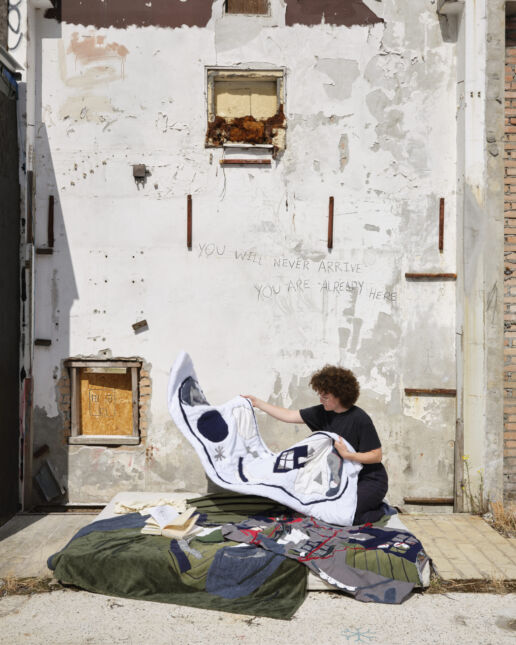
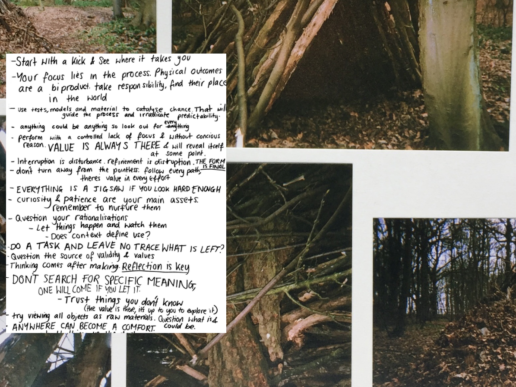
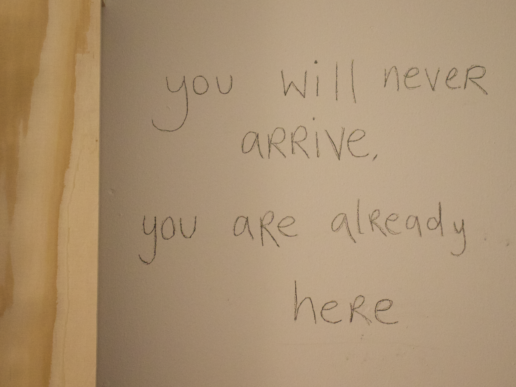
———————————————————————–
THIS MIGHT ALSO BE INTERESTING FOR YOU
SPRING.SUMMER 26 FABRIC HIGHLIGHTS & MATERIAL NOVELTIES – PART V
19. January 2025
Their philosophy,“Drawing art with threads, conveying emotions through embroidery,” ensures every product is not just visually stunning but also deeply meaningful.
The Source Collection’s News at MUNICH FABRIC START
19. January 2025
Neutral sand mélange and off-white jacquards set a sophisticated tone, while soft yarn jersey pieces bring effortless comfort.
Additionals Trends Spring.Summer 26 – Part 7
18. January 2025
Whether haptic or visual - it's all about contrasts, which in combination provide impulses and demand new ways of thinking. Perfect for brands that want to make bold statements!
















